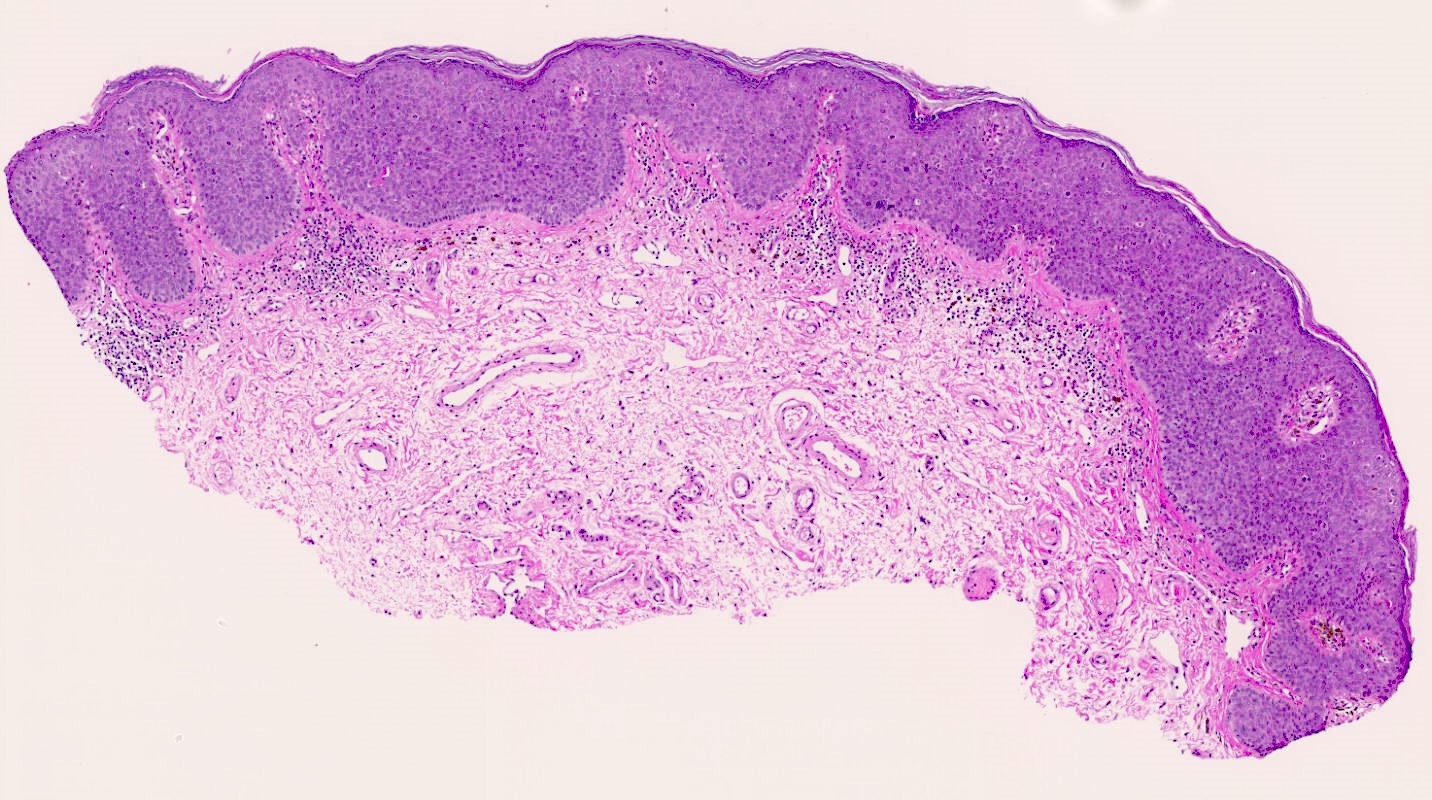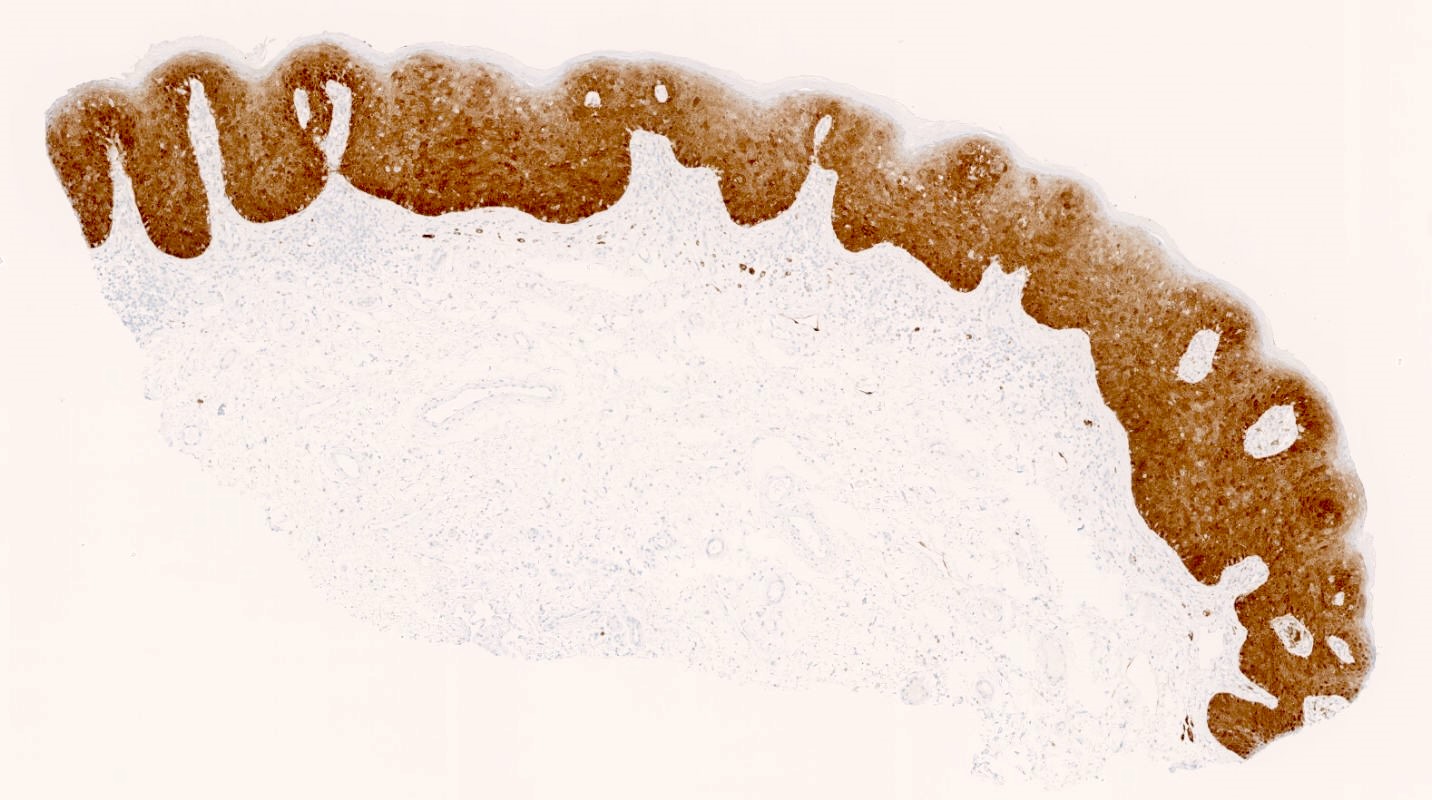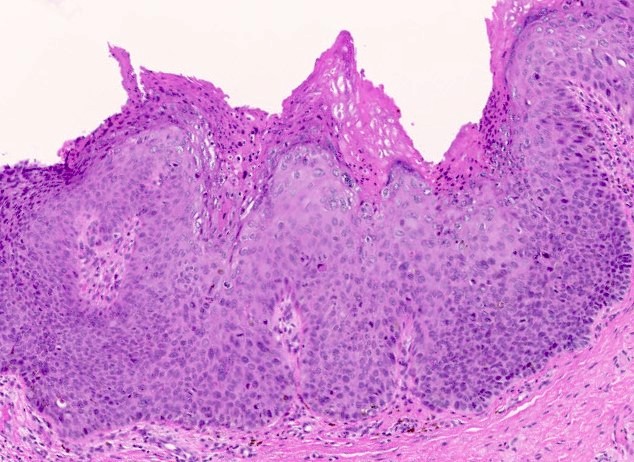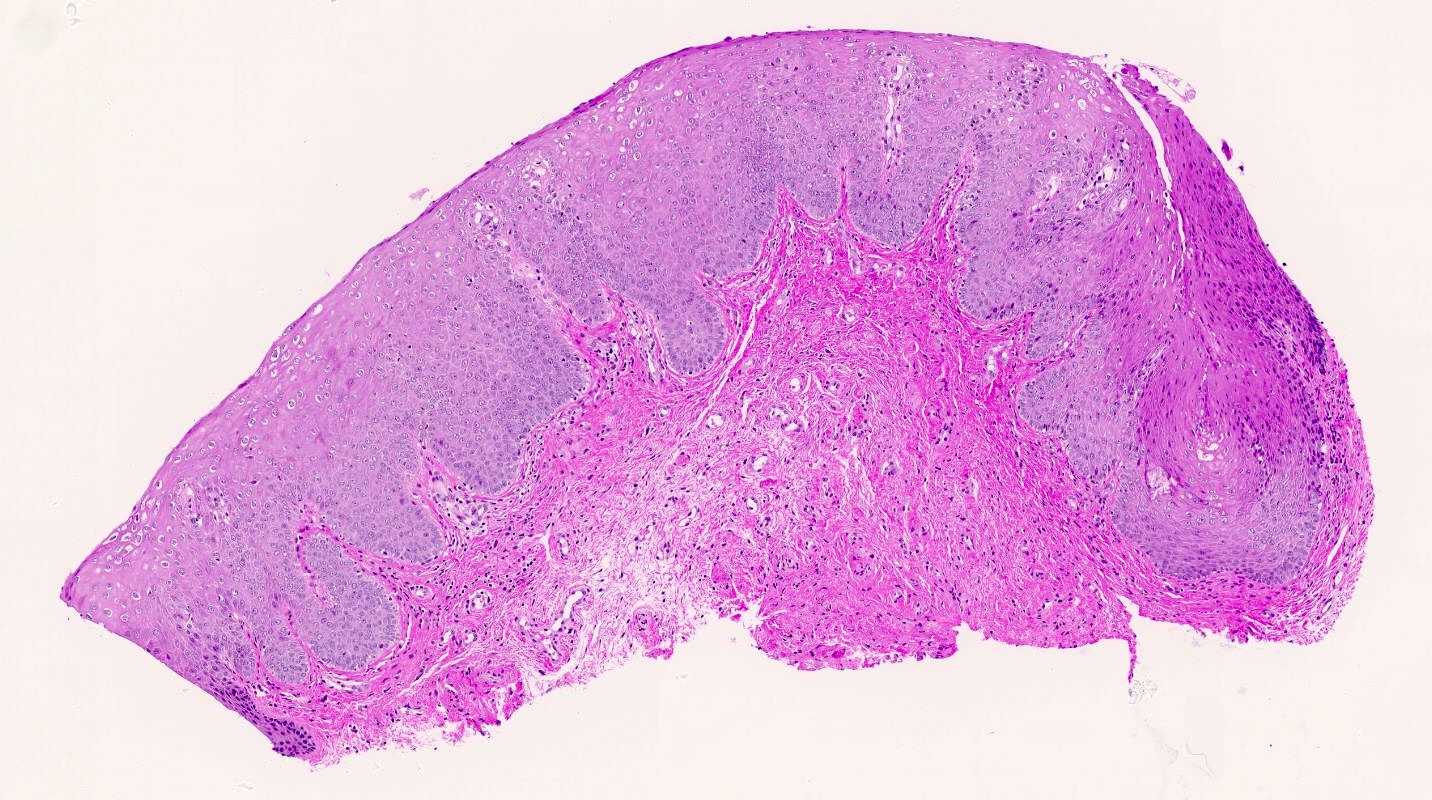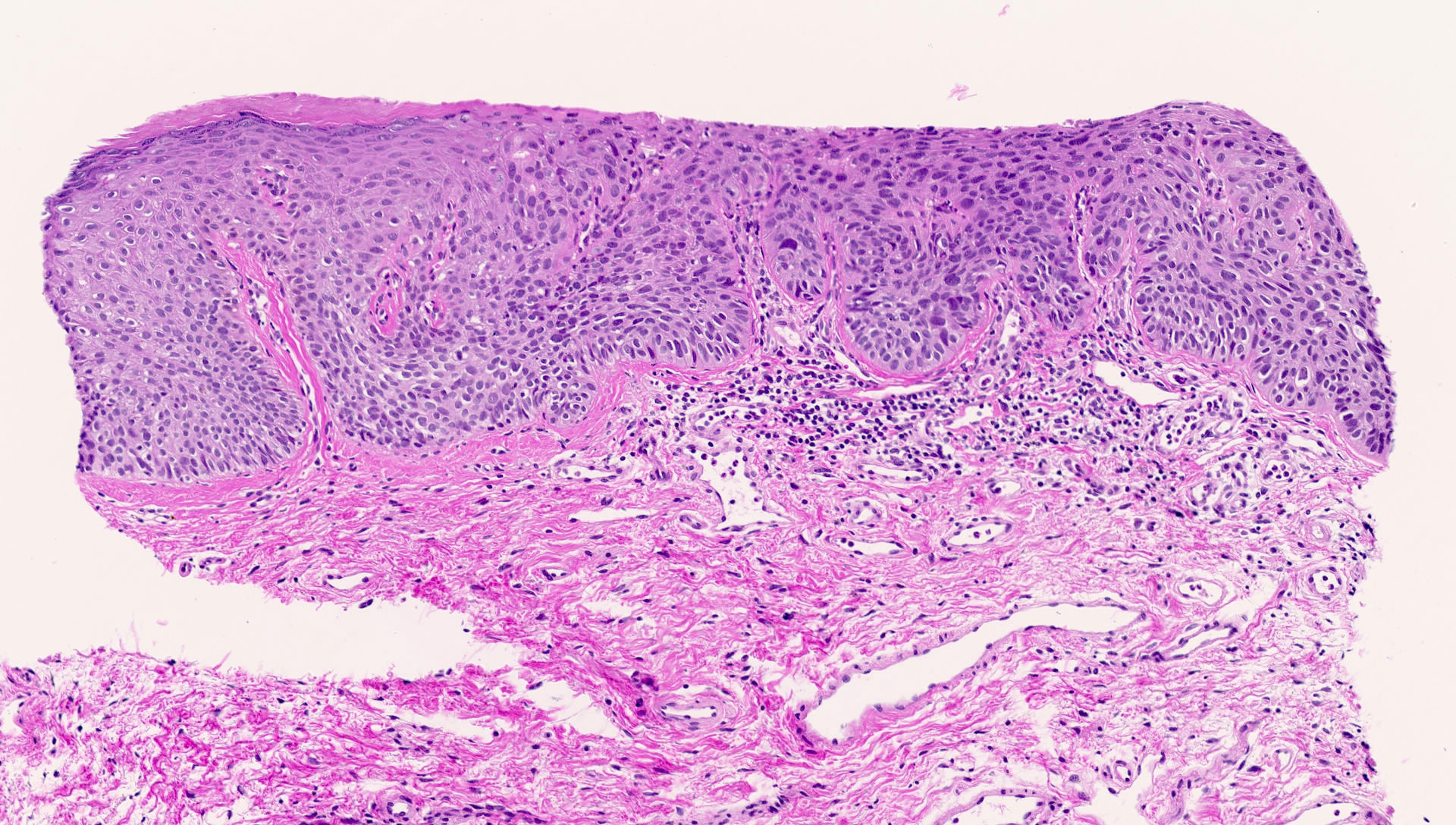Table of Contents
Definition / general | Essential features | Terminology | ICD coding | Epidemiology | Sites | Pathophysiology | Etiology | Clinical features | Diagnosis | Prognostic factors | Case reports | Treatment | Clinical images | Microscopic (histologic) description | Microscopic (histologic) images | Positive stains | Negative stains | Molecular / cytogenetics description | Sample pathology report | Differential diagnosis | Additional references | Board review style question #1 | Board review style answer #1 | Board review style question #2 | Board review style answer #2Cite this page: Choschzick M. HPV associated SIL. PathologyOutlines.com website. https://www.pathologyoutlines.com/topic/vulvaVIN.html. Accessed May 12th, 2024.
Definition / general
- Squamous intraepithelial lesion (SIL) is the morphological manifestation of HPV infection, both low and high risk types
Essential features
- Precursor lesion of HPV associated vulvar carcinoma
- p16 positivity in block type pattern (strong diffuse nuclear or nuclear / cytoplasmic staining)
- Harbors clinically undetected carcinomas in up to 20% of cases (J Gynecol Oncol 2017;28:e27)
Terminology
- Low grade squamous intraepithelial lesion (LSIL): vulvar intraepithelial neoplasia 1, low grade vulvar intraepithelial neoplasia, condyloma accuminatum, mild dysplasia, condyloma/VaIN 1 (Pathology 2016;48:291)
- High grade squamous intraepithelial lesion (HSIL): vulvar intraepithelial neoplasia of usual type (u-VIN), high grade vulvar intraepithelial neoplasia, vulvar intraepithelial neoplasia 2, vulvar intraepithelial neoplasia 3, moderate, severe dysplasia, VaIN 2, VaIN 3
ICD coding
Epidemiology
- Reproductive age women
- High grade squamous intraepithelial lesion is the most frequent (> 90%) vulvar intraepithelial neoplasia type
- More common in patients with HIV
- Risk factors: smoking, oral contraception, herpes infection, HPV infection elsewhere
- Often component of multitopic lower genital tract neoplasia
- References: Ecancermedicalscience 2015;9:531, Gynecol Oncol 2017;145:298
Sites
- Frequently multifocal (70%)
- Introitus, labia minora, labia majora, posterior fourchette, periclitoral
- Fornix and upper portions of the vagina, multifocal
Pathophysiology
- HPV integrates in the host genome or resides episomally
- Virus proteins E6 and E7 promote cell transformation and proliferation due to suppression of p53, upregulation of telomerase and stabilization of retinoblastoma protein (Nat Rev Cancer 2002;2:342)
Etiology
- High grade squamous intraepithelial lesion: HPV high risk types, most common HPV type 16, others 18, 31, 33, 45
- Low grade squamous intraepithelial lesion: HPV low risk 6 / 11 and high risk types (~40%) (Int J Gynecol Pathol 2017;36:486)
Clinical features
- White, pink or red macules or elevated plaques
- Papules or verrucae with pruritus or asymptomatic
- Some lesions are pigmented
- Acetic acid positive
- Reference: Best Pract Res Clin Obstet Gynaecol 2014;28:1051
Diagnosis
- Punch biopsy
Prognostic factors
- Most low grade squamous intraepithelial lesions regress spontaneously, low risk for progression to high grade squamous intraepithelial lesion or invasive carcinoma
- Up to 9% of high grade squamous intraepithelial lesion progress to squamous cell carcinoma if untreated, 3 - 4% if treated; spontaneous regression possible; recurrence rate ~15% after treatment (Gynecol Oncol 2005;97:645)
Case reports
- 6 young women aged 20 to 36 with regression of vulvar intraepithelial neoplasia 3 (J Low Genit Tract Dis 2012;16:56)
- 36 year old pregnant woman with vulvar intraepithelial neoplasia 3 (Ann Agric Environ Med 2017;24:459)
- 44 year old woman with vulvar intraepithelial neoplasia 3 and Behçet’s disease (BMC Res Notes 2016;9:172)
- 49 year old woman with multinucleated atypia (Cutis 2005;75:118)
- 51 year old woman with vulvar intraepithelial neoplasia 3 (Int J Clin Oncol 2011;16:610)
- 75 year old woman with vulvar intraepithelial neoplasia 3 (Int J Womens Dermatol 2016;2:35)
Treatment
- Wide local excision if cancer is suspected; otherwise local excision, laser ablation, local topical agent imiquimod (Obstet Gynecol 2016;128:937)
- No treatment for low grade squamous intraepithelial lesion if asymptomatic
Microscopic (histologic) description
- High grade squamous intraepithelial lesion
- Acanthosis, papillomatosis, enlarged atypical nuclei in all cell layers including middle and upper third of the epithelium (full thickness atypia), suprabasal mitoses, atypical mitosis, extension in hair follicles and skin appendages (Pathology 2013;45:214)
- Warty type vulvar intraepithelial neoplasia: extensive hyper and parakeratosis at the surface, some koilocytosis possible, condylomatous appearance with wide rete pegs which extend into the subepithelial stroma
- Basaloid type vulvar intraepithelial neoplasia: atypical immature parabasal type cells in the entire epithelium, numerous mitotic figures
- Rarely pagetoid pattern of vulvar intraepithelial neoplasia is observed simulating extramammary Paget disease
- Various types often admixed, classification of the predominant type, distinction of types has no known clinical relevance
- Can be a component of a condyloma
- Foci of unsuspected invasion in up to 20% cases (J Gynecol Oncol 2017;28:e27)
- Low grade squamous intraepithelial lesion
- Acanthosis / papillomatosis, atypical koilocytosis in upper layers, usually mild atypia of immature cells and mitoses limited to the lower third, binucleated epithelial cells
Microscopic (histologic) images
Positive stains
- Squamous cell markers: p63, CK5/6
- High grade squamous intraepithelial lesion
- Nuclear or nuclear and cytoplasmic p16 positivity involving at least the lower one third of epithelium with frequent extension upward (J Low Genit Tract Dis 2012;16:205)
- Numerous Ki67 positive nuclei in middle and higher portions
- Heterogeneous p53 staining with varying intensities especially in lower epithelial layers (wild type pattern)
- CK17 shows only patchy, weak to moderate staining in superficial cell layers (Virchows Arch 2018;473:739)
- Low grade squamous intraepithelial lesion
- p16 usually negative but may be rarely positive in block type pattern in the lower third of the epithelium
- Ki67 is elevated, mostly in the lower third of the epithelium, preserved compartments
- Immunohistochemically positive HPV detection in koilocytic cells in a subset of cases depending on the antibody used
Molecular / cytogenetics description
- HPV DNA/mRNA positive
Sample pathology report
- Labium minor, left side, biopsy:
- High grade squamous intraepithelial lesion (vulvar intraepithelial neoplasia 2-3) (see comment)
- Comment: p16 is positive (block type).
Differential diagnosis
- High grade squamous intraepithelial lesion
- Invasive squamous cell carcinoma (versus involvement of skin adnexa):
- Desmoplasia, irregular contours, inflammatory response, distorted architecture are features indicative of invasion
- Paget disease:
- Positive for CK7, CEA and mucin
- p16 may be positive (Int J Gynecol Pathol 2013;32:221)
- Melanoma:
- Positive for melanoma markers (S100, HMB45, melanA, tyrosinase, SOX10)
- Basal cell carcinoma:
- Peripherial palisading
- BerEP4 positive
- Seborrheic keratosis:
- Keratin pearls, uniform cells without atypia
- Differentiated vulvar intraepithelial neoplasia:
- Invasive squamous cell carcinoma (versus involvement of skin adnexa):
- Low grade squamous intraepithelial lesion
- Squamous cell hyperplasia, lichen simplex:
- Ki67 limited to basal cell layers
- Squamous cell hyperplasia, lichen simplex:
Additional references
Board review style question #1
Board review style answer #1
Board review style question #2
- Which immunohistochemical stain shows a block type pattern in high grade squamous intraepithelial lesion?
- CK17
- Ki67
- p16
- p53
- SOX2
Board review style answer #2







